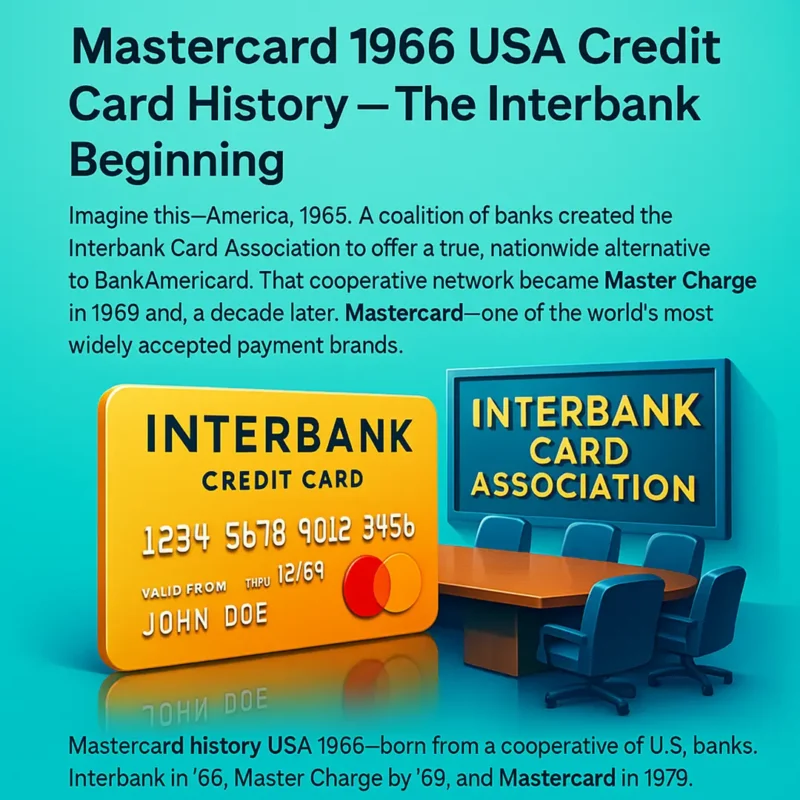Mastercard 1966 USA Credit Card History — The Interbank Beginning
Introduction to Mastercard History 1966 USA
Mastercard’s history began in 1966, when a group of U.S. banks formed the Interbank Card Association—a cooperative network created to compete with BankAmericard. This landmark step led to the launch of Master Charge in 1969 and, a decade later, the Mastercard brand that became one of the world’s most trusted payment networks.
This article covers the complete Mastercard history 1966 USA, including Interbank Card Association, Master Charge, and the rebrand to Mastercard.
Estimated reading time: 5 min read
Published: Sep 21, 2025

The Backstory Before 1966
Before Mastercard’s history 1966 USA began, the American credit market was already changing. In the 1950s, Diners Club launched the first charge card, quickly followed by the rise of BankAmericard in 1958. As the U.S. economy grew in the postwar years, consumer demand for credit expanded nationwide. But BankAmericard was a closed system, controlled by one bank, limiting broader adoption. Competing banks needed their own cooperative network to stay relevant—and that gap led directly to the creation of the Interbank Card Association in 1966.
Mastercard 1966 USA Credit Card History
📖 Introduction
The Mastercard 1966 USA Credit Card History is not just a story of a payment card—it marks the beginning of a cooperative banking revolution in America. In 1966, several U.S. banks formed the Interbank Card Association (ICA) to create a nationwide alternative to BankAmericard. This move introduced the idea of a shared credit network, which later became Master Charge (1969) and eventually the global Mastercard brand in 1979.
🌱 Origins and First Launch (1966)
In 1966, a coalition of American banks launched the Interbank Card Association, uniting institutions to compete with BankAmericard’s early dominance.
Surprise: For the first time, consumers had a credit card backed by multiple banks—not just one issuer.
Challenge: Competing with BankAmericard was tough. Fraud cases, initial losses, and customer hesitation slowed growth.
Achievement: By 1969, the card rebranded as Master Charge, which gained nationwide recognition.
Marketing Innovation: ICA pioneered open membership, allowing many U.S. banks to join and issue the same card—a unique concept at the time.
Milestone: In 1979, Master Charge officially became Mastercard, later transforming into one of the most widely accepted payment networks in the world.
🚀 Business Model and Early Growth
The Mastercard 1966 USA Credit Card History shows how the Interbank Card Association introduced features that reshaped U.S. banking:
Cooperative Banking Model: Multiple banks joined under one system, giving customers freedom beyond a single bank’s card.
Merchant Acceptance: Retailers quickly adopted the Interbank card because it expanded sales and reduced dependence on BankAmericard.
Risk Management: Fraud and payment delays existed, but banks realized shared responsibility made the model sustainable.
Consumer Trust: Once users started carrying the Interbank card, loyalty grew—driving long-term usage.
Social Impact: By late 1960s, having a credit card became a sign of financial progress in America.
🌍 National Expansion and Competition
The Interbank Card Association and later Master Charge expanded rapidly across the U.S., challenging BankAmericard’s dominance.
Rapid Growth: Within just a few years, ICA spread nationwide, offering Americans a real alternative.
Master Charge Launch (1969): The rebrand strengthened recognition and gave ICA a competitive edge.
Licensing Model: Banks across the U.S. could join and issue cards under the same brand—accelerating expansion.
Mastercard Rebrand (1979): To modernize globally, Master Charge became Mastercard, symbolizing worldwide reach.
Impact of Competition: Mastercard’s rise pushed Visa (BankAmericard’s successor) to innovate technology and improve services.
💻 Technological Innovations
The Mastercard 1966 USA Credit Card History is also the story of rapid payment innovations that changed global finance forever:
1960s: The Interbank Card Association pioneered shared credit card networks, setting the stage for safer multi-bank systems.
1970s: With the launch of Master Charge (1969), electronic authorization improved security and reduced fraud.
1990s: Mastercard EMV chip cards strengthened protection, becoming a global standard.
2000s: Mastercard rolled out Contactless and Tap-to-Pay solutions, boosting speed and convenience.
Today: From digital wallets to mobile pay and secure online platforms, Mastercard remains a leader in U.S. and global payments.
🧑🤝🧑 Impact on American Consumers
The Mastercard history 1966 USA had a long-lasting effect on American life and spending culture—
For the first time, consumers could shop at thousands of merchants under one shared banking network.
Middle-class families accessed essentials like homes, cars, and education more easily with Mastercard’s revolving credit.
Small businesses benefited as more customers paid using Master Charge and later Mastercard.
The foundation of today’s “Buy Now, Pay Later” culture was reinforced by multi-bank cards.
Credit history and consumer trust grew stronger, shaping modern American financial habits for generations.
⚠️ Criticism and Challenges
The Mastercard 1966 USA Credit Card History was not without hurdles—early years came with serious challenges:
Delinquencies: Many U.S. cardholders failed to pay bills on time, causing losses across banks in the Interbank network.
Fraud: Criminals exploited system weaknesses, forcing stronger fraud-prevention methods.
Merchant Resistance: Some shopkeepers resisted Mastercard because of transaction fees.
Consumer Education: It took years to teach Americans how revolving credit and Master Charge actually worked.
Competition: Constant rivalry with BankAmericard (later Visa) kept Mastercard USA under pressure to innovate.
🏆 Legacy
Today, Mastercard stands as one of the largest global payment networks—an evolution that started with the Interbank Card Association in 1966.
Over 3 billion Mastercard holders worldwide.
Accepted in 200+ countries and territories.
Billions of transactions daily, from credit to debit to prepaid.
Mastercard is a leader in contactless, mobile, and digital payments in the USA and globally.
👉 From its beginnings as the Interbank Card Association (1966) to Master Charge (1969) and finally Mastercard (1979), this journey shaped the financial future of generations.
⭐ Key Features of Mastercard (1966–1979)
The Mastercard 1966 USA Credit Card History highlights several groundbreaking features introduced by the Interbank Card Association and later Master Charge:
Revolving Credit: Allowed Americans to pay a minimum balance and carry the rest forward month-to-month.
Multi-Bank Network: Launched in 1966 by U.S. banks, the Interbank system gave consumers freedom beyond a single bank’s card.
Merchant Acceptance: Rapid adoption by retailers, restaurants, and service providers boosted growth.
Technology Upgrades: From magnetic stripe innovation to EMV chip and later contactless methods, Mastercard led U.S. payment security.
Global Expansion: By 1979, Master Charge rebranded as Mastercard, accepted in 200+ countries worldwide.
🎯 Lessons for Consumers
The story of the Mastercard history 1966 USA teaches today’s consumers timeless lessons:
Be Responsible With Credit
👉 Paying bills on time strengthens your credit score, while delays lead to debt and stress.Credit Is a Tool, Not Just Spending Power
👉 Used wisely, a Mastercard can provide relief during emergencies and help manage major expenses.Competition Benefits Consumers
👉 The rivalry between Mastercard and Visa gave Americans more benefits, lower fees, and stronger protections.Stay Updated With Technology
👉 From magnetic stripe in the 1970s to today’s tap-to-pay and digital wallets, Mastercard shows why adapting to innovation matters.
🔑 Conclusion
The Mastercard 1966 USA Credit Card History is more than a product launch—it’s the moment that reshaped modern finance. When U.S. banks formed the Interbank Card Association in 1966, they created a competitive alternative to BankAmericard. That bold step led to Master Charge in 1969 and, a decade later, the Mastercard brand recognized worldwide.
Today, Mastercard is one of the largest global payment networks—powering secure transactions, digital wallets, and innovations that keep shaping consumer finance in the USA and beyond.
👉 Want to see the full journey? Read the Complete Mastercard History
💡 Top Credit Quote Code

Top Credit Quote — Your Trusted Guide to USA Credit Cards & Smart Finance
🏆 About the Top Credit Quote Editorial Team
Top Credit Quote is an independent U.S.–focused credit card editorial group. We analyze issuer disclosures, compare card perks, and model real-life spending to help you find the best credit options in the USA. Our promise: honest reviews, clear guidance, and zero pay-to-play rankings.
✅ Evidence-based reviews: issuer pricing, benefits, and fine print explained clearly.
✅ Real value checks: first-year + ongoing rewards vs. annual fees.
✅ Weekly updates: fresh offers, rate changes, and fast edits.
✅ Plain-English advice: who a credit card is for—and who should skip it.
✅ Independent recommendations: affiliate links never influence ratings.
✅ Corrections policy: if we miss something, we fix it—fast.
